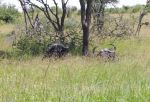Driving in Kenya is an experience. In general, I don’t like driving in the city and try to avoid it at all cost. But, now that I’m back analyzing my samples at the International Livestock Research Institute (ILRI), I’m driving back and forth between the lab and my house on a daily basis. This constitutes a drive of about 15 km and takes about 30-35 minutes. No big deal……right?
The roads here are very narrow and the matatu drivers (bus drivers) thrive on anarchy. Thus, the key is to be very alert. For example, I never know what Kenyans are trying to say when they use their turning signals, as sometimes a right blinker means ‘I’m going to turn right’, sometimes it means ‘It’s okay for you to pass me on my right’, and sometimes it means ‘Don’t pass on my right, there is a car coming’. And, with all the rain that we’ve had over the past few days, the limited drainage, and the improper grading of the roads here, many of the roads are flooded, causing complete chaos. In the US, there would be a police officer directing traffic. Here, no such luck. It’s just every man, woman, and child for himself. Chaos.
Tonight, I had to stay late at the lab. I generally do not like to drive at night or when it rains. So, even though I left the lab at 6:30 pm (it get’s dark at 7:15 pm), all the daylight was gone with the excessive rain. As you can imagine, my vehicle is not the best for driving at night. It is older than I am and doesn’t have any defogger, vent, etc. The lights and wipers work well, but not when compared to newer, more modern vehicles. Thus, I’m forced to drive with the window partially open and have to continually wipe the inside of the glass to clear the fogged windows. Since there are no streetlights, it’s hard to see anything, especially since no one seems to care that their high beams are blinding and shining directly into the eyes of on-coming traffic. And, the rain releases the heat from the surface, with the effect being a very rainy/foggy ride. Add a few hundred people walking along the roadside with no shoulder to the mix, the hatching of millions of flying insects the size of small birds, potholes that you could fit a VW bus in, and speed ‘humps’ that are unmarked so that they are nearly impossible to see unless ingrained into memory, and the drive can become extremely tense (Coincidently, this little 15 km drive from the lab to my house has nearly 30 speed ‘humps’, as Kenyan’s seem to be in love with placing a speed ‘hump’ wherever possible (for example, at the top of a hill)).
In any event, I made it home safely. I would have liked to take a picture to show you what it was like, but that was an extra step that I was unable to take on my own. Maybe next time.














